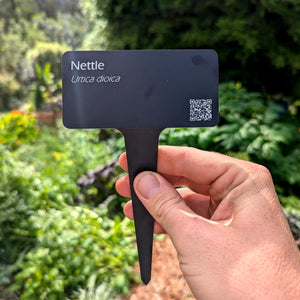
Salvia chamelaeagnea
Salvia chamelaeagnea

- Low stock - 15 items left
- Inventory on the way

Usually available: All year
Life cycle: Perennial
Height: 1.5 - 2m
Position: Full sun
Soil preference: Well drained
This is how we pack and send your Herb Plants to all states except TAS & WA
You will receive
- 1 Salvia Chamelaeagnea Herb Plant in a 50 X 75mm tube - General growing instructions
All of our Herb Plants are grown organically with certified organic potting mixes and fertilizers
Botanical Name:
Salvia chamelaeagnea is a dense evergreen shrub growing to 2 meters with a spread of about 1 meter. The plant has many strong, upright square shaped stems that hold oppositely positioned leaves. Sometimes leaves are also found on short side branches. The leaves are green, slightly hairy and occasionally have toothed margins. The leaves also have tiny dots or glands which emit a strong scent and exude a bitter tasting, sticky substance when touched. The flowers are held in thick whorls and take up the top third of each stem or branch, where the flowers are held on small branchlets extending up from the main stem.
The corolla, or flower, colour can range from blue, mauve, pink or white. The most common corolla colour is blue for the top lobe and white on the lower lobe, leading to the common name Rough Blue Sage. The large calyx is a reddish purple colour and is also covered in hairs and dotted with glands. The mauve blue flowers are bunched together with the calyces held in amongst the flowers creating an interesting contrast. The blooming period is from late spring and summer through to autumn, but each plant may only bloom for one to two months.
Rough Blue Sage is from the diverse fynbos or ‘fine bush’ group of plants in South Africa. The Afrikaans word ‘fynbos’ refers to the many scrub-like and shrub plants found in the country’s South Western Cape region. Like many Australian plants, this salvia is adapted to survive wildfires common to the South African Cape region by being able to re-grow from the woody root stock. South Africa has 27 salvia species with different characteristics.
The salvia family has over 900 members with an extensive history as culinary, medicinal and ornamental plants. Ornamental salvias have become collectors items, as gardeners try to find a place in their garden for each and every one. There are salvias that will suit every type of soil and climate. More information on the Salvia genus and Common Sage (Salvia officinalis) may be found on our Common Sage page.
Growing Conditions
Rough Blue Sage is an easy to grow plant, with a tough constitution. Like many South African salvias, it is well suited to Australian conditions. The best growth is obtained with a full sun position. Although this is a heat tolerant plant, it does prefer to have a regular water supply. In its native habitat Rough Blue Sage prefers to grow in natural water seepage areas, such as near river beds or areas of sandy soil amid the rocks that might collect water. A well-drained, enriched soil with regular deep watering, especially in the dry months will ensure goo d growth. In South African conditions the winters are often dry and with rain falling during summer months, this helps plants cope with the heat. Hot conditions without rainfall or extra water may yield very different results!
Trimming the plant after its blooming season is required to maintain tidiness and vigour. After several years, the plant may become quite woody so new plants could be introduced. If planted in groups the introduction of each plant can be staggered so there is always a prime garden specimen. This salvia does well in large containers with a free draining soil mix.
This plant will grow readily from seed, but flower colour may be unpredictable. Insects pollinate this salvia by using the bottom lobe as a landing platform allowing the anthers to drop pollen on to their back. Later, when they visit another plant, the curved stigma will touch on to its back and collect the pollen allowing for fertilization and seed production. Due to variable flower colour, you will need to propagate directly from your chosen parent plant, to ensure that the colour is replicated. Cuttings can be taken from the base of the plant from new shoots in spring and early summer.
Medicinal Uses
Like most salvias or bush sages, this plant has been used for medicinal purposes such as treating coughs and colds, colic and heartburn. A tea may be made by chopping the leaves finely and steeping in a cup of boiling water.
All information provided on this website is for informational purposes only. Please seek professional advice before commencing any treatment.





